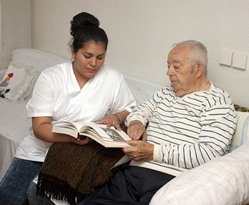How to Choose the Best RN College near White South Dakota
 Choosing the right nursing college near White SD may seem like a complicated endeavor, especially if you have no idea what to look for in a good degree program. As you may presently know, to practice as a registered nurse, you must acquire the necessary education and training to become licensed. So it is essential that you research and assess the qualifications of each school you are contemplating before enrolling in your final selection. Unfortunately, too many future students base their determination solely on the price of tuition and the proximity of the school. Deciding on the least expensive school or the one that is nearest to your home is probably not the most reliable way to pick a nursing program. There are several crucial additional things to check out before you determine where to attend classes. But before we examine that checklist, let’s first review the nursing degree choices that are offered together with what the jobs of nurses are in our health system.
Choosing the right nursing college near White SD may seem like a complicated endeavor, especially if you have no idea what to look for in a good degree program. As you may presently know, to practice as a registered nurse, you must acquire the necessary education and training to become licensed. So it is essential that you research and assess the qualifications of each school you are contemplating before enrolling in your final selection. Unfortunately, too many future students base their determination solely on the price of tuition and the proximity of the school. Deciding on the least expensive school or the one that is nearest to your home is probably not the most reliable way to pick a nursing program. There are several crucial additional things to check out before you determine where to attend classes. But before we examine that checklist, let’s first review the nursing degree choices that are offered together with what the jobs of nurses are in our health system.
Request Free Information on Nursing Schools Below
Nursing Degrees
There is more than one degree option available to become a nurse. And to become a Registered Nurse (RN), a student must attend an accredited school and program. A nursing student can earn a qualifying degree in as little as 2 years, or advance to attain a graduate degree for a total of 6 years. Following are some short descriptions of the nursing degrees that are available to aspiring students in the White SD area.
- Associates Degree. The Associate Degree in Nursing (ADN) is usually a 2 year program offered by community colleges. It preps graduates for an entry level job in nursing in medical facilities including hospitals, clinics or nursing homes. Many utilize the ADN as an entry into nursing and afterwards achieve a more advanced degree.
- Bachelor’s Degree. The Bachelor of Science in Nursing (BSN) provides more expansive training than the ADN. It is usually a four year program offered at colleges and universities. Licensed RNs may be able to complete an accelerated program based on their prior training or degree and professional experience (RN to BSN). Those applying to the program might wish to progress to a clinical or administrative position, or be more competitive in the employment market.
- Master’s Degree. The Master of Science in Nursing (MSN) is generally a 2 year program after receiving the BSN. The MSN program provides specialization training, for instance to become a nurse practitioner or focus on administration, management or teaching.
When a graduating student has acquired one of the above degrees, she or he must pass the National Council Licensure Examination for Registered Nurses (NCLEX-RN) so as to become licensed. Further requirements for licensing vary from state to state, so make sure to get in touch with the South Dakota board of nursing for any state requirements.
Click Here to Get Free Information on Nursing Schools Near You!
Why Choose the Nursing Profession?
 Nurses are an integral component of a White SD medical team, and for a large number of patients, their primary care providers. A career in nursing can lead to many opportunities, such as research, health care education and specialty areas of practice. Nurses enter the profession for various reasons, among the most notable are its personal and practical advantages. Nurses provide direct, one-on-one care to patients. Most patients in a hospital or home care environment have more contact with nurses than with physicians. Nurses commonly go into the profession due to a desire to tend to the needs of patients, including in instances of short-term treatment of illness and long-term care of chronic ailments. This human side of the medical profession, as opposed to the analytical or research related aspects, is attractive to many who elect to enter into a nursing career. Nurses have extensive applicable skills and can select from a number of work settings, including home care facilities, physician’s offices, health clinics, community centers and hospitals. Also, nurses can progress into a variety of specializations, including substance addictions, critical care, neonatology and genetics. While most nurses deliver direct patient care, others choose to be educators, policy advisers and pharmaceutical representatives.
Nurses are an integral component of a White SD medical team, and for a large number of patients, their primary care providers. A career in nursing can lead to many opportunities, such as research, health care education and specialty areas of practice. Nurses enter the profession for various reasons, among the most notable are its personal and practical advantages. Nurses provide direct, one-on-one care to patients. Most patients in a hospital or home care environment have more contact with nurses than with physicians. Nurses commonly go into the profession due to a desire to tend to the needs of patients, including in instances of short-term treatment of illness and long-term care of chronic ailments. This human side of the medical profession, as opposed to the analytical or research related aspects, is attractive to many who elect to enter into a nursing career. Nurses have extensive applicable skills and can select from a number of work settings, including home care facilities, physician’s offices, health clinics, community centers and hospitals. Also, nurses can progress into a variety of specializations, including substance addictions, critical care, neonatology and genetics. While most nurses deliver direct patient care, others choose to be educators, policy advisers and pharmaceutical representatives.
Registered Nurse Job Responsibilities
 Registered nurses are the largest occupation in the medical delivery system. RNs practice in a large number of different medical environments, including White SD hospitals, private practices, outpatient clinics, nursing homes and even schools. Their basic job is to aid doctors in the treatment of their patients. However, the particular duties of a registered nurse will depend on their job or specialization along with where they work. A portion of the responsibilities of an RN may include:
Registered nurses are the largest occupation in the medical delivery system. RNs practice in a large number of different medical environments, including White SD hospitals, private practices, outpatient clinics, nursing homes and even schools. Their basic job is to aid doctors in the treatment of their patients. However, the particular duties of a registered nurse will depend on their job or specialization along with where they work. A portion of the responsibilities of an RN may include:
- Administering medications
- Overseeing patients
- Conducting physical examinations
- Managing care
- Supervising LPNs, LVNs and nurse aides
- Educating patients and their families
- Managing health records and charts
Nurses with a more advanced degree may have more high level job duties and responsibilities. Nurse practitioners (NP), for instance, must hold a Master’s Degree and often work more independently than their RN counterparts. They can administer primary or specialty care services, prescribe medications, and diagnose and treat routine illnesses or injuries.
Nursing Online Programs
 Enrolling in nursing programs online is growing into a more favored way to obtain instruction and acquire a nursing degree. Some schools will require attending on campus for part of the training, and almost all programs call for a certain number of clinical rotation hours performed in a local healthcare facility. But since the remainder of the training can be accessed online, this method may be a more accommodating solution to finding the time to attend classes for many White SD students. Pertaining to tuition, a number of online degree programs are less costly than other on campus options. Even additional expenses such as for commuting and study materials can be reduced, helping to make education more economical. And numerous online programs are accredited by organizations like the Commission on Collegiate Nursing Education (CCNE) for BSN and MSN degrees. And so if your job and family obligations have left you with very little time to pursue your academic goals, perhaps an online nursing school will make it easier to fit a degree into your hectic schedule.
Enrolling in nursing programs online is growing into a more favored way to obtain instruction and acquire a nursing degree. Some schools will require attending on campus for part of the training, and almost all programs call for a certain number of clinical rotation hours performed in a local healthcare facility. But since the remainder of the training can be accessed online, this method may be a more accommodating solution to finding the time to attend classes for many White SD students. Pertaining to tuition, a number of online degree programs are less costly than other on campus options. Even additional expenses such as for commuting and study materials can be reduced, helping to make education more economical. And numerous online programs are accredited by organizations like the Commission on Collegiate Nursing Education (CCNE) for BSN and MSN degrees. And so if your job and family obligations have left you with very little time to pursue your academic goals, perhaps an online nursing school will make it easier to fit a degree into your hectic schedule.
What to Ask Nursing Programs
 Now that you have chosen which nursing degree to enroll in, as well as whether to attend your classes on campus near White SD or on the web, you can use the following pointers to begin narrowing down your choices. As you probably are aware, there are numerous nursing schools and colleges throughout South Dakota and the United States. So it is necessary to lower the number of schools to choose from so that you will have a manageable list. As we previously discussed, the location of the school and the price of tuition are most likely going to be the primary two factors that you will consider. But as we also stressed, they should not be your sole qualifiers. So prior to making your final choice, use the following questions to evaluate how your pick measures up to the other schools.
Now that you have chosen which nursing degree to enroll in, as well as whether to attend your classes on campus near White SD or on the web, you can use the following pointers to begin narrowing down your choices. As you probably are aware, there are numerous nursing schools and colleges throughout South Dakota and the United States. So it is necessary to lower the number of schools to choose from so that you will have a manageable list. As we previously discussed, the location of the school and the price of tuition are most likely going to be the primary two factors that you will consider. But as we also stressed, they should not be your sole qualifiers. So prior to making your final choice, use the following questions to evaluate how your pick measures up to the other schools.
- Accreditation. It’s a good idea to make sure that the degree or certificate program along with the school is accredited by a U.S. Department of Education acknowledged accrediting agency. Besides helping ensure that you get a premium education, it may assist in obtaining financial aid or student loans, which are oftentimes not available in White SD for non-accredited schools.
- Licensing Preparation. Licensing criteria for registered nurses differ from state to state. In all states, a passing score is needed on the National Council Licensure Examination (NCLEX-RN) together with graduation from an accredited school. Some states require a specified number of clinical hours be performed, as well as the passing of additional tests. It’s imperative that the school you are enrolled in not only provides an outstanding education, but also preps you to satisfy the minimum licensing standards for South Dakota or the state where you will be practicing.
- Reputation. Visit internet rating services to see what the assessments are for each of the schools you are considering. Ask the accrediting organizations for their reviews too. Also, get in touch with the South Dakota school licensing authority to find out if there are any complaints or compliance issues. Finally, you can speak with some White SD healthcare organizations you’re interested in working for after graduation and ask what their assessments are of the schools as well.
- Graduation and Job Placement Rates. Find out from the RN schools you are considering what their graduation rates are as well as how long on average it takes students to finish their programs. A low graduation rate may be an indication that students were displeased with the program and dropped out. It’s also essential that the schools have high job placement rates. A high rate will not only verify that the school has a good reputation within the White SD healthcare community, but that it also has the network of relationships to help students obtain employment.
- Internship Programs. The most ideal way to obtain experience as a registered nurse is to work in a clinical setting. Essentially all nursing degree programs require a certain number of clinical hours be completed. A number of states have minimum clinical hour prerequisites for licensing too. Ask if the schools have associations with White SD hospitals, clinics or labs and help with the positioning of students in internships.
Colleges With Good Nursing Programs White SD
Fast Track RN Training Online White South Dakota
Enrolling in the ideal nursing program is arguably the most critical phase to starting a new career in the medical care field. There are many aspects that you should think about when selecting a nursing college. These variables will be prioritized differently depending on your current career objectives, obligations, and economic situation. As we have stressed within this content, it is essential that you choose a nursing school and a degree program that are each accredited and have exceptional reputations within the healthcare community. You originally came to this website due to your interest in Fast Track RN Training Online and wanting more information on the topic Online Colleges For Nursing.. However, by using our checklist of qualifying questions, you will be able to produce a shortlist of schools to pick from so that you can make your final selection. And with the appropriate degree and training, combined with your hard work and drive to succeed, you can become a practicing nurse in White SD.
More South Dakota Nursing Locations
£sd
£sd (occasionally written Lsd, spoken as "pounds, shillings and pence" or pronounced /ɛlɛsˈdiː/ ell-ess-dee) is the popular name for the pre-decimal currencies once common throughout Europe, especially in the British Isles and hence in several countries of the British Empire and subsequently the Commonwealth. The abbreviation originates from the Latin currency denominations librae, solidi, and denarii.[1] In the United Kingdom, which was one of the last to abandon the system, these were referred to as pounds, shillings, and pence (pence being the plural of penny).
This system originated in the classical Roman Empire. It was re-introduced into Western Europe by Charlemagne, and was the standard for many centuries across the continent. In Britain, it was King Offa of Mercia who adopted the Frankish silver standard of librae, solidi and denarii in the late 8th century,[2] and the system was used in much of the British Commonwealth until the 1960s and 1970s, with Nigeria being the last to abandon it in the form of the Nigerian pound on 1 January 1973.
Under this system, there were 12 pence in a shilling and 20 shillings, or 240 pence, in a pound. The penny was subdivided into 4 farthings until 31 December 1960, when they ceased to be legal tender in the UK, and until 31 July 1969 there were also halfpennies ("ha'pennies") in circulation. The advantage of such a system was its use in mental arithmetic, as it afforded many factors and hence fractions of a pound such as tenths, eighths, sixths and even sevenths and ninths if the guinea (worth 21 shillings) was used. When dealing with items in dozens, multiplication and division are straightforward; for example, if a dozen eggs cost four shillings, then each egg was priced at fourpence.
